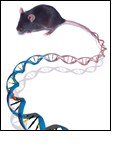Return to Online
Education Kit
|
 |
 |
 Previous Event | Next Event Previous Event | Next Event 
2002: Mouse Genome Sequenced

The International Mouse Genome Sequencing Consortium (which was part of the Human Genome Project) completed a high-quality draft sequence of the mouse genome. The paper describing the mouse genome also compared it to a recently completed draft of the human genome. The mouse sequence is an important resource for unraveling the mysteries of the human genome. DNA sequences that have been conserved between the two are presumably functionally important. This means that mice can be used in laboratory experiments to investigate gene functions. The mouse data will allow researchers to explore how mouse genes and their human counterparts contribute to health and disease. Such research is expected to enhance the understanding of human disease and facilitate the development of new treatment options. As with the human genome sequence, the mouse data is freely available to researchers who can use it without restriction.
More Information
Comparison of human and mouse genomes - some highlights:
- The mouse genome is composed of 2.5 billion bases. This is about 14 percent shorter than the human genome. The human genome has more repeated DNA sequences than does the mouse genome.
- Although mice and humans are separated by 75 million years of evolution, 90 percent of the mouse genome can be aligned with large segments of chromosomes in the human genome.
- The number of genes estimated to be in the mouse genome was about 30,000. This is similar to the number estimated to be in the human genome. As with humans, this number was later lowered to the 20,000—25,000 range.
Reference:
Waterson, R.H., Lindblad-Toh, K., Birney, E,. Rogers, J., et al. Initial sequencing and comparative analysis of the mouse genome. Nature, 420:520-562. 2002. [PubMed]
 Previous Event | Next Event Previous Event | Next Event 
Last Reviewed: April 10, 2008
|

